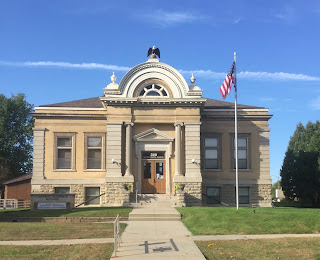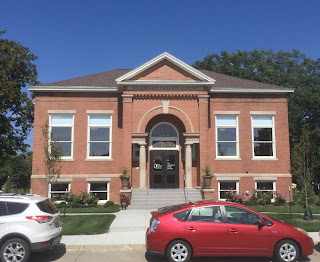The Carnegie in Iowa Falls gave me my first spontaneous, audible “Wow” of these travels. Each one I come upon gives the needle on my delight meter a nudge, but the magnificence of this one gave it an extra jolt and even before I noticed it’s coup de grace—an eagle perched atop it’s roof.
It’s soft yellow hue, fine stonework, inset columns, subtle ornamentation, classic light fixtures, large windows, “Carnegie Ellsworth Library” over it’s entry and setting on a slight hill with a block all to itself gave it an extra degree of magnificence. It had lost the distinction of being the town library, but still had a position of prominence as a historical museum.
It was one of two Carnegies in Iowa Falls, as Ellsworth College, just a few blocks away, also had a library funded by Carnegie. It was of more traditional design, but still the most noble building on the small campus. It’s facade identified it as “Ellsworth College Library” but it was now known as “Bullock Jones Hall” and had been converted into classrooms and administrative offices.
Just seven miles away along the Iowa River in the tiny town of Alden was another Carnegie. It had a slight addition to its side with a ground level entrance replacing the original entrance up a flight of stairs
The original building was adorned with two plaques. One dated to the opening of the library stating, “The erection of this building was made possible through the generosity of Mr. Andrew Carnegie. A.D. 1914.” The second was more recent after the building had been placed on the National Register of Historic Places. Regrettably the library wasn’t open, it being Saturday evening.
I biked on for another hour until near dark and nestled into a corn field once again. The pattern of a shower during the night continued, leaving me with a slightly muddy ground cloth the next morning when I rolled up my tent. Fortunately the temperatures have moderated with it now fall, so I didn’t need to be alarmed when I discovered the water bottle cage on the underside of my frame containing one of my four water bottles broke off as I was riding. I was startled that I hadn’t been aware of it detaching. My three remaining bottles were mostly full, so I had no concerns of thirst.
Amongst my road side gatherings so far has been a child’s-sized water bottle that I picked up as a curiosity and perhaps as a premonition. I had yet to use it, but I can now enlist it as my emergency water bottle. So far the pickings have been ho-hum, just the usual—several bungee cords, two license plates and just one coin, a nickle. No neckerchiefs yet.
If I were the destitute vagrant that I’m mistaken for, I’ve had the opportunity for free food besides the occasional dumpster fare I add to my diet. I’ve come upon a couple of what I thought were Little Free Libraries, but they were dispensing food, not books. One called itself a “Blessing Box” and was located at a commuter parking lot at the intersection of two roads out in the country.
The other identified itself as a “Little Free Pantry” and was located by a library. Both stated, “Take what you need, give what you can.” Neither had more than a handful of basic items. One had a loaf of bread, a box of pancake mix and a bottle of syrup. The other had a box of macaroni and cheese, some fruit cups and some breakfast bars.
The next two Carnegies were both exemplary enough to register delayed “Wows” after fully taking in their majesty. The first in Hampton facing the town park had the splendor of a baronial estate. It paid full homage to Carnegie with “Gift of Andrew Carnegie” in its facade below “Hampton Public Library.” And inside its entrance were the profound words of Carnegie—“A library outranks any other one thing a community can do to benefit its people.”
Forty miles down the road the dignified Carnegie in Eagle Grove placed its entrance at the diagonal of its corner lot between four columns that were set in a curve. A simple “C,” as if it were a Masonic symbol, was inlaid above the entry.
The former “Free Public Library” etched in stone that had once graced the entrance was now a cracked relic residing to the side of building that had been transformed into a museum.
I was happy to camp in a grassy cemetery that evening, allowing me to wipe the mud from my tent. I stop at cemeteries two or three times a day in France for water, but I have never camped in one in France, as rarely do they have any grass. Cemeteries aren’t as common in the US, and never have I found a water spigot in one, not that I go searching with water so easy to come by at service stations, but I do occasionally take advantage of cemeteries as a place to camp in my US travels.
With my many thousands of miles biking around France engrained in me, my subconscious thought can often place me in France as I’m cycling along. I’ll be momentarily tricked into thinking a high silo in the distance is a village’s cathedral, as is a common site in France, before I’m reminded I’m in the land of commerce, not culture.
There are many aspects of French touring that I miss (the picturesque towns, the never bland scenery, the ease of camping both wild and in municipal campgrounds, the level of respect the touring cyclist is accorded, roadside picnic tables, toilettes publique, water in cemeteries, not to mention The Tour de France and the many cycling memorials and museums scattered all over the country), but touring in the US affords me some of my favorite things that France doesn’t—an abundance of libraries, ice dispensing machines in service stations and fast food restaurants, roadside scavenging, dumpster diving, and businesses not closing for lunch.
France can actually be cheaper than the US, with its subsidies making supermarket food less expensive. And there is a greater variety to the food choices. Plus there is menthe á l’eau. Both the US and France offer exemplary cycle touring. It would be next to impossible to rate one over the other as their pluses and minuses come close to cancelling each other out. I couldn’t be more pleased to be riding the roads of either and absorbing all they have to offer.































